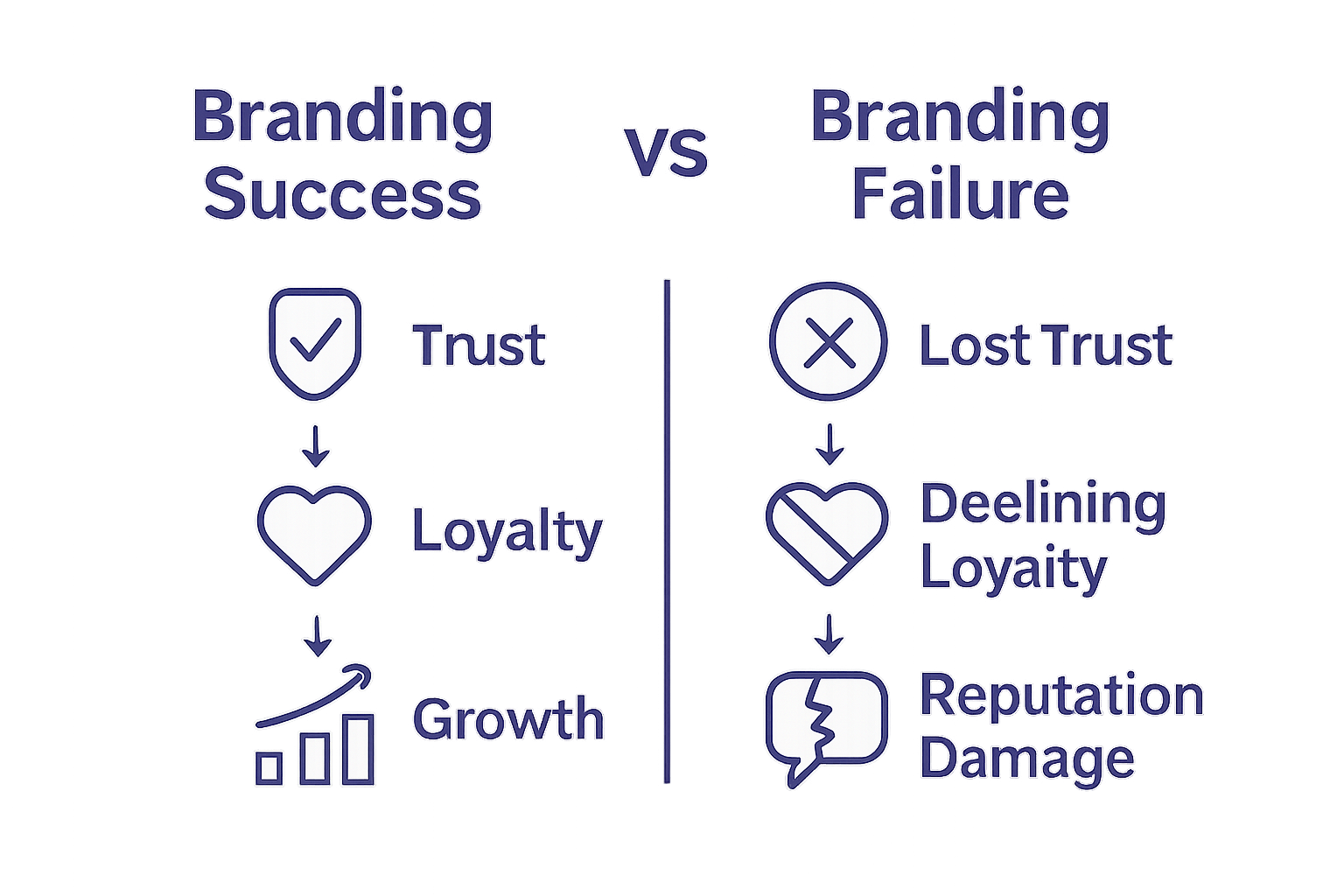Branding disasters are more common than you might think and one wrong move can haunt a company for years. In fact, brand failures have caused some companies to lose millions almost overnight. You might expect these failures to come from small businesses stumbling in unfamiliar territory. Yet the real shock is that some of the biggest and most well-known brands have suffered the worst damage from basic missteps in their messaging and identity.
Table of Contents
- What Are Branding Failures And Their Impact?
- The Reasons Behind Branding Failures
- The Role Of Audience Perception In Branding Failures
- Case Studies: Lessons From Notable Branding Failures
- How To Avoid Branding Failures In Your Business
Quick Summary
| Takeaway | Explanation |
|---|---|
| Branding failures damage reputation and finance | Strategic misalignment can lead to a loss of customer trust and financial setbacks for organizations. |
| Authenticity is key for brand success | Brands need genuine, transparent communication to maintain consumer credibility and trust in their promises. |
| Understand your audience’s perception | Regularly gather feedback and adapt to your audience’s evolving views to avoid disconnects between expectation and delivery. |
| Establish clear brand guidelines | A unified brand narrative is essential; ensure all departments align their messaging and understand core values. |
| View failures as learning opportunities | Analyze branding failures to refine strategies and develop more resilient, empathetic brand management approaches. |
What Are Branding Failures and Their Impact?
Branding failures represent critical moments when an organization’s strategic communication, visual identity, or market positioning catastrophically misaligns with audience expectations, resulting in significant reputation damage and potential financial losses. These strategic missteps can transform a seemingly robust brand into a cautionary tale about the fragile nature of corporate perception.
Understanding the Core Mechanics of Branding Failures
At its fundamental level, a branding failure occurs when a company’s external presentation fundamentally contradicts its intended message or core values. This misalignment can emerge through multiple channels: messaging inconsistencies, tone-deaf marketing campaigns, visual identity mistakes, or profound disconnects between promised brand experiences and actual customer interactions.
The impact of branding failures extends far beyond immediate marketing metrics. They can:
- Erode customer trust permanently
- Trigger substantial financial losses
- Damage long-term market positioning
Psychological Dimensions of Brand Perception
Customers develop complex emotional relationships with brands. When these relationships are disrupted through significant branding failures, the psychological response can be swift and unforgiving. People do not merely react to marketing messages they experience them, forming intricate narratives about brand reliability and authenticity.
Professional organizations understand that branding is more than visual aesthetics or catchy slogans. It represents a comprehensive promise of value, experience, and integrity. When this promise is broken, consumers interpret it as a fundamental breach of trust. Learn more about building strong brand foundations.
The consequences of branding failures can manifest across multiple dimensions: reputational damage, decreased customer loyalty, reduced market share, and potentially irreversible negative brand associations. Smart organizations recognize these risks and invest heavily in consistent, authentic brand communication strategies that align closely with their core organizational values and customer expectations.
The Reasons Behind Branding Failures
Branding failures rarely emerge from a single isolated mistake, but instead develop through complex interconnected organizational dynamics that systematically undermine a company’s strategic communication and market perception. Understanding these root causes requires a nuanced examination of the multifaceted challenges that can derail even the most sophisticated brand strategies.
The following table compares the most common root causes of branding failures, helping readers quickly distinguish between issues of strategy and authenticity discussed in the article:
| Root Cause | Description | Consequences |
|---|---|---|
| Strategic Misalignment | Internal division leads to inconsistent messaging and brand confusion | Fragmented narrative, unclear positioning |
| Communication Breakdown | Poor cross-department coordination undermines brand consistency | Mixed messages, weakened trust |
| Authenticity Gaps | Brand statements diverge from actual company culture or actions | Credibility loss, negative perception |
| Perception Gaps | Brand promise does not match customer experience | Disengagement, decreased loyalty |

Strategic Misalignment and Communication Breakdown
At the core of most branding failures lies a profound disconnection between an organization’s internal understanding and external communication. Companies frequently experience strategic misalignment when different departments operate in silos, creating inconsistent messaging that fragments the brand’s core narrative. This fragmentation occurs when marketing teams, product developers, customer service representatives, and leadership fail to maintain a cohesive understanding of the brand’s fundamental value proposition.
Key organizational vulnerabilities that contribute to branding failures include:
- Lack of clear, unified brand guidelines
- Inconsistent communication across different channels
- Misunderstanding of target audience expectations
- Insufficient internal communication protocols
Authenticity and Perception Gaps
Modern consumers demand genuine, transparent brand experiences. When organizations present an inauthentic version of themselves, they risk significant credibility damage. These perception gaps emerge when companies attempt to craft marketing narratives that do not genuinely reflect their operational realities, corporate culture, or actual product capabilities.
Explore effective brand communication strategies that help organizations maintain alignment between their promised and delivered experiences.
The most critical factor in preventing branding failures is developing a deep, empathetic understanding of how customers perceive and interact with the brand. Organizations must continuously monitor their market positioning, gather comprehensive feedback, and remain adaptable to evolving consumer expectations. Successful brands recognize that branding is not a static achievement but an ongoing, dynamic process of communication, reflection, and strategic refinement.
The Role of Audience Perception in Branding Failures
Audience perception represents the critical lens through which consumers interpret, evaluate, and ultimately validate a brand’s strategic communication. This complex psychological process transforms marketing messages from mere corporate statements into deeply personal narratives that can either reinforce or dramatically undermine an organization’s intended brand identity.
The Psychological Foundations of Brand Interpretation
Consumers do not passively receive brand messaging they actively construct meaning based on their unique experiences, cultural backgrounds, and personal expectations. Perception operates as a sophisticated filtering mechanism that compares incoming brand communications against an individual’s pre-existing mental models, determining the credibility and resonance of corporate narratives.
Key psychological factors influencing brand perception include:
- Prior personal experiences with the brand
- Social and cultural contextual influences
- Emotional associations and memory triggers
- Individual value systems and belief structures
To clarify the key psychological factors affecting how audiences interpret and respond to branding, the following table summarizes the main influences on brand perception outlined in the article:
| Psychological Factor | Description |
|---|---|
| Prior Personal Experiences | Past interactions or history with the brand shape current perception |
| Social and Cultural Influences | Cultural background and social context inform interpretation and expectations |
| Emotional Associations | Memories and emotions triggered by the brand impact trust and loyalty |
| Value Systems and Beliefs | Individual core values determine brand resonance and credibility |
Cognitive Dissonance and Brand Credibility
When a brand’s communicated identity conflicts with a consumer’s lived experience, cognitive dissonance emerges. This psychological tension occurs when marketing promises contradict actual product performance or corporate behavior. Consumers experiencing such disconnects quickly disengage, interpreting the discrepancy as a fundamental breach of trust.
Discover strategies for authentic brand communication that align messaging with genuine organizational capabilities.
Successful brands recognize that audience perception is not a static construct but a dynamic, continuously evolving relationship. Organizations must develop sophisticated, empathetic communication strategies that acknowledge the complexity of consumer interpretation. This requires ongoing dialogue, transparency, and a willingness to adapt brand narratives in response to shifting audience expectations and experiences.
Case Studies: Lessons from Notable Branding Failures
Branding failures serve as powerful educational tools, offering profound insights into the complex dynamics of corporate communication, consumer psychology, and strategic positioning. By examining real-world scenarios where organizations encountered significant reputational challenges, businesses can develop more nuanced and resilient brand strategies.
Strategic Missteps in High-Profile Brand Narratives
Some of the most instructive branding failures emerge from seemingly sophisticated organizations that fundamentally misunderstood their audience’s expectations. When companies prioritize creative messaging over authentic representation, they risk substantial credibility damage. These strategic missteps often reveal deeper organizational disconnects between marketing intentions and actual consumer experiences.
Key characteristics of memorable branding failures include:
- Tone-deaf marketing campaigns
- Significant misalignment between brand promise and delivery
- Inadequate crisis communication strategies
- Fundamental misunderstandings of target audience values
Psychological Impact of Brand Miscalculations
Consumer reactions to branding failures demonstrate the intricate emotional connections people develop with corporate identities. When trusted brands deviate from their established narratives, audiences experience a sense of betrayal that extends beyond simple product dissatisfaction. These moments transform from marketing mishaps into profound trust disruptions that can permanently alter consumer perceptions.
Explore strategies for building resilient brand communications that anticipate and mitigate potential perception risks.
Successful organizations treat branding failures not as catastrophic endpoints but as critical learning opportunities. By analyzing these case studies with intellectual humility, companies can develop more sophisticated, empathetic approaches to brand management. The most adaptive brands recognize that vulnerability and transparent communication are far more valuable than maintaining an illusion of perfection.

How to Avoid Branding Failures in Your Business
Preventing branding failures requires a proactive, holistic approach that integrates strategic planning, comprehensive market understanding, and continuous organizational alignment. Successful businesses recognize that effective brand management is not a one-time achievement but an ongoing process of strategic refinement and adaptive communication.
Developing a Robust Brand Foundation
Organizational coherence represents the cornerstone of sustainable brand development. Companies must establish clear, comprehensive brand guidelines that transcend mere visual aesthetics and penetrate every aspect of corporate communication. This involves creating a unified narrative that aligns internal operations, employee interactions, and external marketing strategies.
Critical elements of a strong brand foundation include:
- Consistent messaging across all communication channels
- Clear articulation of core organizational values
- Comprehensive understanding of target audience expectations
- Mechanisms for continuous brand performance evaluation
Strategic Market Intelligence and Audience Alignment
Successful brand management demands continuous learning and adaptation. Organizations must develop sophisticated market intelligence capabilities that enable real-time understanding of audience perceptions, emerging trends, and potential communication risks. This requires implementing robust feedback mechanisms, conducting regular market research, and maintaining organizational flexibility.
Explore comprehensive strategies for building a resilient brand that can navigate complex market dynamics.
Ultimately, avoiding branding failures requires more than defensive strategies. It demands a proactive, empathetic approach that views brand management as a dynamic dialogue with audiences. Businesses must cultivate organizational cultures that prioritize authenticity, transparency, and continuous learning. By embracing vulnerability and maintaining genuine connections with consumers, organizations can transform potential branding challenges into opportunities for deeper engagement and trust-building.
Turn Branding Challenges Into Results With Titans of Print
Branding failures can shake your business to the core. When your message misses the mark or your signs do not align with your brand values, customer trust and credibility suffer. The article discussed how inconsistent communication, lack of unified brand guidelines, and missed expectations create cracks in your image. You need solutions that keep your identity strong and your audience engaged.
Let Titans of Print help you regain control. We offer expert printing services that ensure your visual presence supports your brand across every touchpoint. From eye-catching building signs and channel letters to impressive tradeshow displays and business essentials, every detail matters. Do not wait for another branding misstep to cost you. Visit Titans of Print today and discover how professional, consistent print solutions can strengthen your brand story. Start building trust again with every print.
Frequently Asked Questions
What are the common causes of branding failures?
Branding failures often stem from strategic misalignment, communication breakdowns, a lack of clear brand guidelines, and authenticity gaps that disconnect consumer expectations from the brand’s actual offerings.
How can a company prevent branding failures?
Companies can prevent branding failures by developing a robust brand foundation, ensuring consistent messaging across all platforms, understanding their target audience deeply, and continuously evaluating brand performance and audience perceptions.
Why is audience perception crucial in branding?
Audience perception is crucial because it shapes how consumers interpret and engage with a brand. A disconnection between a brand’s message and consumer experience can lead to distrust and reputational damage, impacting long-term loyalty and market positioning.
What should organizations do after experiencing a branding failure?
After a branding failure, organizations should analyze the situation with humility, gather feedback, and adjust their strategies. Treating failures as learning opportunities can help build more resilient brand communications that better align with consumer expectations.






